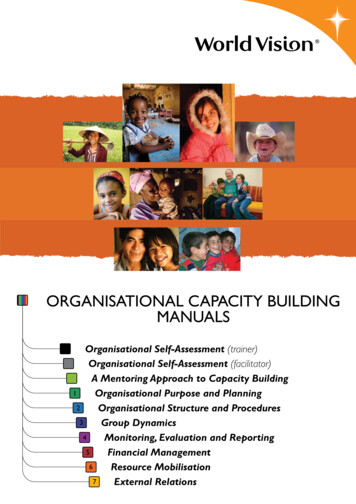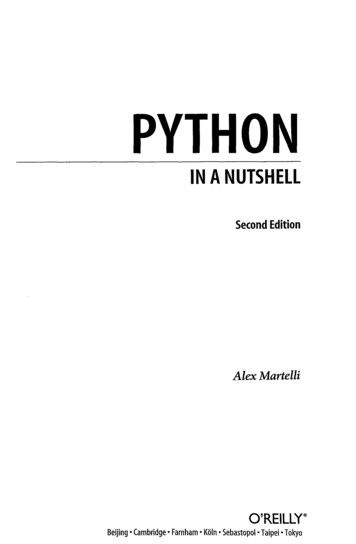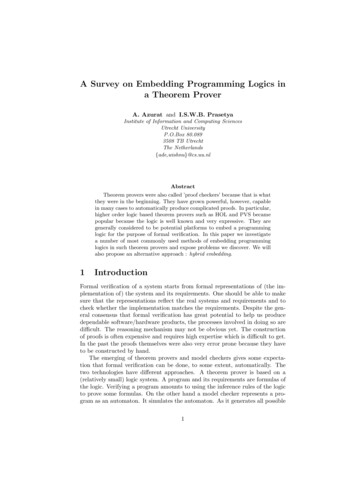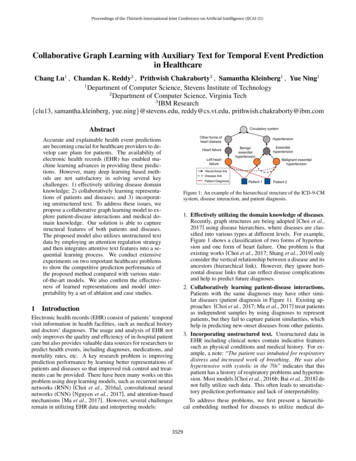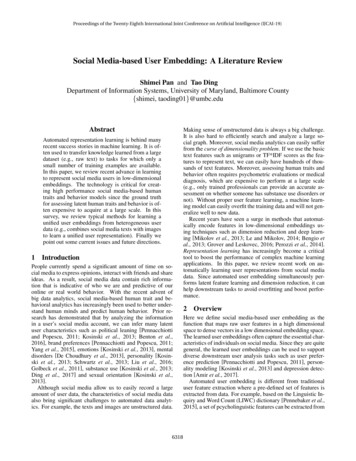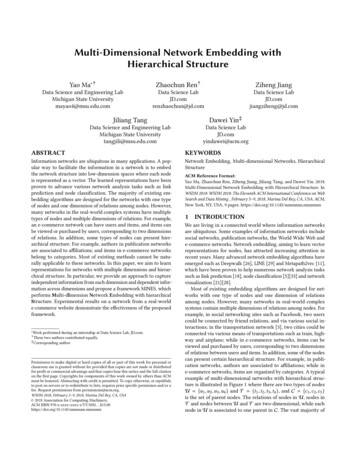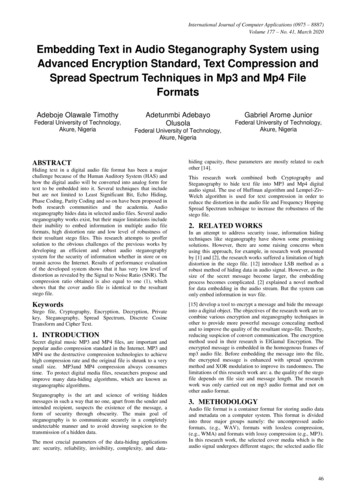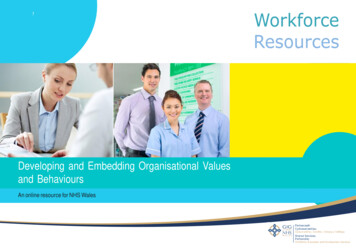
Transcription
1Developing and Embedding Organisational Valuesand BehavioursAn online resource for NHS Wales
2Introduction“Value is not only created through people, it is co-created throughpeople inspired by a common purpose, working to shared values,inspired and engaged, giving more of themselves to a commonand shared endeavour.”Tony Manwaring, Chief exeCuTive of ToMorrow’s CoMpanyThis is the conclusion that is reached byacademics, practitioners and others suchas Robert Francis QC (Chair of the MidStaffordshire Report). Accepting that strategy,objectives and values are the founding pillars oforganisations. Values are now often recognisedas the most important element as they arethe qualities that transform an organisation’smission and vision into reality.As each of us is ruled by our own values andthis generates our behaviour, ensuring thatwe work as effectively as possible togethermeans agreeing to live by some shared values.Values, then, have to be developed by thosewho live by them so that they are owned bythose using them. Once developed, they needto be reinforced at every opportunity throughrecruitment, training and personal performanceaccountability. Above all, they need to be livedrather than just being a written statement.
3User Guide This interactive toolkit has been developed as a guide to help organisations develop theirorganisational values and behaviour standards. After reading this, you can navigate your way around the rest of the resource to get detailedinformation to help develop values and behaviours in your organisation. This resource is a ‘click and go’ guide which enables you to find the information you want onspecific topics quickly and directly. The contents page shows what each section of the document covers. Click the section you wantand you will go straight to it. When you are at a section page, click on the topic you are interested in to find out whatinformation and tools are available. You can click on the button at any time if you want to returnto the contents page.
4Navigation guideTo help you navigate your way around the resource there area number of clickable buttons that take you back or forward toset places in the resource:takes you back tothe beginningtakes you to thecontents pagetakes you to the‘Quick Guide’ pagetakes you to the‘Key Contacts andFurther Help’ pagetakes you to theprevious pagetakes you to thenext pagetakes you to anexternal webpage
5Contentssection 1: Why are values important to the best organisations?page 6section 2: What is the evidence?page 7section 3: What should be considered?page 8section 4: Developing Values – Ideas for group facilitationpage 9section 5: Embedding and reinforcing organisational valuespage 27section 6: Examples of best practicepage 36section 7: Further informationpage 47Click on any of the titles above to take you to the relevant page.
6Section 1: Why are values important to the best organisations?Professor Michael West highlights this furtherhaving identified that those successful groups,teams and organisations have key things incommon:– They recognise they are a “team”– The have shared goals/objectives– They have a mutually agreed shared “way ofdoing things”– They get together regularly to work out howto do things better Critically, “how we do things around here”needs to be at heart of what the group doesand how it goes about doing it. With the values in place, teams, groupsand organisations need to identify whatbehaviours support and contradict the valuesso that each of us can be clear about what’sexpected of us. Behaviours which live thevalues need to be reinforced whilst thosethat contradict them need to be challenged. Individuals and groups in successfulorganisations know their values andbehaviours and use them to govern theirdecisions and actions. Leaders have a crucialrole to play in helping others to do this.
7Section 2: What is the evidence?Links to some useful articles which provide the current evidence on the importance of values inorganisations are shown below.ArticlesMid Staffs Public Inquiry Report (Francis)Achieving Organisational Change through Values AlignmentChallenging the Culture within the NHSPrinciples not valuesOrganizational values a dynamic perspectiveWeb com
8Section 3: What should be considered?There are a number of codes of conduct which provide an assurance framework for public protection the following links are to the Regulatory bodiesand Nationally Agreed Codes of conduct that relate to the staff groups below.Medical StaffGeneral Medical Council – Good Medical PracticePharmacistsRoyal Pharmaceutical Council, Medicines, Ethics and PracticeDental StaffGeneral Dental Council StandardsHealthcare Support Workers in WalesCode of Conduct for HCSW in WalesNursing and Midwifery StaffNMC CodeNHS Managers and HCSW EmployersCode of Conduct for NHS ManagersHCPC Allied Health ProfessionalsHCPC Standards of conduct, performance and ethicsCode of Practice for HCSW Employers in Wales
9Section 4: Developing Values – Ideas for group facilitationThe following links provide practical ways that the development of values can be facilitated in yourorganisation: Using a World Cafe approach Personal Values Questionnaire Values and Criterial Equivalents ExerciseClick on any of the italicised links above to take you to the relevant page.
10Facilitation Ideas and ToolsThe following links provide practical ways that the development ofvalues can be facilitated in your organisation: World Café Personal Values Questionnaire Values and Criterial Equivalents ExerciseClick on the italicised links above to take you to the relevant page.Section 4: Developing Values – Ideas for group facilitation
11What is a World Café?World Café Conversations are an intentionalway to create a living network of conversationaround questions that matter.A Café Conversation is a creative processfor leading collaborative dialogue, sharingknowledge and creating possibilities for actionin groups of all sizes.The challenges of life in the 21st Centuryrequire us to find new ways to accessthe opinions, wisdom, creative ideas andintelligence inherent within the workforce.The need for collaboration, insight andcoordinated action has never been greater.Café Conversations are one way thatcommunities, businesses, governments, andpeople from all walks of life are using to createa common purpose, share knowledge, andmake more intelligent decisions together.Section 4: Developing Values – Ideas for group facilitation
12The seven design principles of World Café1. Set the context2. Create hospitable space3. Explore questions that matter4. Encourage everyone’s contribution5. Cross-pollinate and connect diverse perspectives6. Listen together for patterns, insights, and deeper questions7. Harvest and share collective discoveriessection 4: Developing values – ideas for group facilitation
13World CaféThe methodology of the World Café is simple: The environment is set up like a café, withtables covered by paper tablecloths, somecolored pens and refreshments. Peoplesit around a table and have a series ofconversational rounds lasting from 20 to 45minutes about one or more questions whichare pre-set At the end of each round, one personremains at each table as the host, while theothers travel to separate tables. Table hostswelcome newcomers to their tables andshare the essence of that table’s conversationso far The newcomers relate any conversationalthreads which they are carrying – and thenthe conversation continues, deepening as theround progresses At the end of the second round, participantsreturn to their original table – or move onto other tables for one or more additionalrounds – depending on the design of theCafé In subsequent rounds they may explore anew question or go deeper into the originalone After three or more rounds, the whole groupgathers to share and explore emergingthemes, insights, and learnings, which arecaptured on flipcharts or other means formaking the collective intelligence of thewhole group visible to everyone so they canreflect on what is emerging in the room At this point the Café may end or it maybegin further rounds of conversationalexploration and inquiry.section 4: Developing values – ideas for group facilitation
14Personal Values QuestionnaireAcademics in the fields of change management,leadership and organisational developmenthave more recently started to acknowledge thepart that personal values play in determiningpeoples’ perceptions of and response todifferent situations. This acknowledgementhas potentially significant implications formanagers. Firstly in understanding our ownvalues better we can become more awareof factors that stimulate our behaviour anddecision making processes. Secondly in betterunderstanding the values of others we cantailor our change and communication strategiesto best influence and positively motivate othersto minimise resistance to change.One of the leading researchers in this field,Shalom Schwartz describes personal values as:“concepts or beliefs, that relateto desirable end-states orbehaviours, transcend specificsituations, guide selection orevaluation of behaviour andevents, and are ordered byrelative importance.”sChwarTz 1996:4He suggests that values are developed in theearlier period of human life and are generallyformed by our late teens, early twenties. Aswe age we become increasingly aware of ourvalues and those of others close to us. Withsection 4: Developing values – ideas for group facilitationmaturity and practice, we become more ableto control our response to situations and thebehaviours of others that challenge our valuesby temporarily flexing our response. However,our values reassert themselves in our behaviouras the situation changes just as bamboo bendsin a strong wind and then reverts to its formerstate.
15Personal Values Questionnaire (cont.)Schwartz’s research identified ten valuesthat are grouped under four super ordinateheadings which he labels as openness tochange, self transcendence, conservation andself enhancement. Each of us has differingrelationships with each value for example aSelf-TranscendencePowerOpenness to changeperson might have a particularly strong affinitywith self direction whilst having a weak affinitywith security.Self-Enhancementsection 4: Developing values – ideas for group facilitationConservation
16Personal Values Questionnaire (cont.)Schwartz also suggests that individual valuesare diametrically opposed to each other forexample a person for whom self direction is aprimary value might least understand or preferthe behaviour of a person for whom securityis a primary value. However a person mighthave self direction as their primary value andthe diametrically opposite security as theirsecondary value. If this occurs then situationsthat require a person to choose between thesevalues are often very challenging.He has also researched the impact that valueshave on our vocational choices. For exampleit is very common for universalism to be aprimary value of those in caring professionssuch as nursing and the allied healthprofessionals. Similarly tradition and conformityare very common amongst those who choosethe finance profession.We live much of our lives without being overlyconscious of our top values. However whensection 4: Developing values – ideas for group facilitationfaced with a situation or behaviour that wedislike, our top values often stimulate us in toaction or at least passive resistance. It is alsobelieved that when living our values we aremost likely to be performing at our best andmost happy. One thing is certain; organisationsare full of continuous interplays betweenindividual, professional and organisationalvalues, thereby making change managementand leadership a very complex process withinthe NHS.
17Personal Values Questionnaire (cont.)so, what are your top threepersonal values?Read down the left hand column of the tableon the next page to identify which three sets ofvalues terms you most closely associate with.Then read across to the right hand columnand the associate value type. The value typeexpresses what motivates people and itsclassification.example 1If freedom, creativity, independent, choosingone’s own goals etc. is highly appealing thenindependent thought and action is yourmotivation which is classified as Self Direction.When you have identified your top threevalues, work out their order by asking yourselfthe question which one of these three can I livewithout. This will identify your third value. Thenask the same question of the remaining twovalues to identify your second and first value.section 4: Developing values – ideas for group facilitationexample 2Self Direction, Universalism and Stimulationare Bob’s top three values. He recognisesthat of these three he can most live without“Independent thought and action” which isSelf Direction. He then asks the same questionin relation to Universalism and Stimulation,recognising that he could not live withoutvariety and stimulation which is Stimulation.Therefore his top three personal valuesin ascending order are Self Direction,Universalism and Stimulation.
18Personal Values Questionnaire (cont.)value TermsFreedom, creativity, independent, choosing one’s own goals, curious,self respectAn exciting life, a varied life, daringPleasure, enjoying lifevalue TypeSelf Direction – “Independent thought and action”Successful, capable, ambitious, influential, intelligentAchievement – “Personal success through demonstrating competenceaccording to social standards”Social power, authority, wealth, preserving, my public image, socialrecognitionPower – “Attainment of social status and prestige, and control ordominance over people and resources”Clean, national security, reciprocation of favours, social order, familysecurity, sense of belonging, healthyObedient, honouring of parents, politeness, self-disciplineSecurity – “Safety, harmony and stability of society, of relationshipsand of self”Conformity – “Restraint of actions, inclinations and impulses likely toupset others and violate social expectations or normsAccepting my portion in life, devout, humble, respect for tradition,moderate, detachmentTradition – “Respect, commitment and acceptance of the customs andideas that one’s culture or religion impose on the individual”Helpful, honest, forgiving, loyal, responsible, a spiritual life, true friendship,mature love, meaning in lifeBenevolence – “Preservation and enhancement of the welfare ofpeople with whom one is in frequent personal contact”Protecting the environment, unity with nature, a world of beauty, broadminded, social justice, wisdom, equality, a world at peace, inner harmonyUniversalism – “Understanding, appreciation and protection for thewelfare of all people and for nature”section 4: Developing values – ideas for group facilitationStimulation – “Need for variety and stimulation”Hedonism – “Pleasure or sensuous gratification for oneself”
19Personal Values Questionnaire (cont.)Using the personal values questionnaire in a workshop Ask participants to read the personal valuesquestionnaire and follow the instructions tohelp them identify their own values Write down each of the 10 values ondifferent pieces of paper, and place on thefloor in a large circle Ask participants to move to their mostimportant value Recognise that values are not extremes andare generally only really obvious when ourown value is contravenedSection 4: Developing Values – Ideas for group facilitation Encourage discussions: “what does this tellthe group about its predominant values?”;“what could this mean to the group and toothers?”; “what’s the predominant value ofthe your team, the organisation?” Repeat with second and third values – drawout observations from others Use the personal values to draw outdiscussions on developing a set of group/organisational values which can becommonly shared. Draw out discussions onwhen these are most likely to be crossed andhow tensions should be dealt with.
20Values and Criterial EquivalentsIntroduction to Values andCriterial EquivalentsValues are those states that are important tous. They are usually stated in abstract terms, forexample : honesty, love, friendship, loyalty, fun,health, integrity, intimacy and freedom. Thereare also organisational values (usually implicit)in the culture and actions of any business.Transformational leaders appeal to the valuesof the people they lead. These are the keys toinstrinsic motivation. To elicit individual values,ask questions like : What is important to you about.? What do you get out of doing this.? What matters to you here ? Why is that important to you.? Why do you want this.? What is important to you about achieving this.?Values may be context dependent, forexample, what people value in relationshipsmay not be the same as what they value intheir professional life. People tend to havecore values that stay stable between differentcontexts. A core value is freely chosen, prizedand acted upon.Rules for ValuesIt is important to know whether your values arebeing fulfilled or not How do you know when your values arebeing fulfilled? How do you know when your values are notbeing fulfilled?You will notice specific evidence that will letyou know when your values are being fulfilledand when they are not. This evidence will besensory specific – what you see and feel.All our values have what NLP calls criterialequivalents – specific behaviours that let usknow when a value is being honoured andwhen a value is not. These are the rules ofbehaviour we set for others and ourselves.To find these criterial equivalents, ask questionslike : What are the specific behaviours that let meknow that my values are being met? What is a behaviour that would honour thisvalue?section 4: Developing values – ideas for group facilitation What are the behaviours that let me knowthis value is not being met? What actions by others really make mefrustrated? Do I feel particularly annoyed when otherpeople do something specific, or not dosomething?It is important to know your own criterialequivalents and the criterial equivalents ofother people, or else we may spend a lot oftime giving to others what we wish to receiveourselves, and in turn, not getting what wewant from others.Critical equivalents can be limiting if : They are very hard or impossible to achieve There are many rules for how your valuescan not be met and few for how they can befulfilled You have no direct control over whether yourvalues are met or not.
21Values and Criterial Equivalents (cont.)How to illicit organisational valuesIt can be seen that the achievement oforganisational values alignment, necessitatesthe implementation of a process that involvestwo distinctive but interdependent actions.Such a process needs to first involve adeliberate values clarification procedure,specifically designed to co-operatively discernthe essential values that need to characterisethe organisation in order for it to successfullyachieve its vision and purpose.personal alignmentIt is proposed that the key to positivelyinfluencing the employee’s individualconsciousness is in helping her/him to knowhow the organisation’s strategic values areformed and how they are to be applied inorder to create an appropriate and successfulorganisational culture.Just as it is important to know and understandthe formational influences on one’s personalvalues so as to recognise how they are able toinfluence one’s behaviour, so too, it is argued,that organisational employees need to knowand understand formational factors of anypreferred strategic organisational values.The people need to be able to clearly see howthese values are important to the organisation’sculture and how the application of thesevalues can lead to a better and more successfulorganisation.They need to be able to know and understandthe antecedent forces that support theadoption of these preferred values.They need to be able to see how the applicationof these values will be able to change theorganisation for the better. It is in this way thatthe employees are able to develop alignmentbetween their personal values and the perceivedstrategic values of the organisation.frameworkA conceptual framework showing theconstituent aspects of an organisation’s culturethat play an integral part in the achievement ofvalues alignment:section 4: Developing values – ideas for group facilitation1. Core MissionThis is the collaboratively discerned ‘controllinginsight’ as to that which is at the very heart ofwhat the group is striving to achieve in order tocreate long-term success of the organisation.It describes what the group needs to do andas such, it is distinct from, but related to,the organisation’s overall vision and missionstatements.The Core Mission is a single sentence thatuses rich descriptive words to describe notonly what is seen as the core business of thecollective group but the manner and means forachieving it.As a controlling insight, the Core Mission must : Apply across a wide range of situations Succinctly describe what would result fromthe achievement of excellence Guide essential action.
22Values and Criterial Equivalents (cont.)In describing these outcomes, the Core Missionbecomes a source of potential organisationalvalues in the mind of all those involved. Hence,these perceived values have meaning for thoseinvolved since each individual can readilyunderstand the significance of these values andtherefore, is in a better position for being ableto willingly support and adopt them.2. performance CapabilitiesThese are the strengths and weaknesses of thegroup, and each individual with respect to theachievement of the Core Mission.transparent process provides clarification as towhat is valued and why it is valued. In this way,the meaningfulness of such values is reinforcedin the minds of the group members.3. success indicatorsThese are the perceived logical consequencesthat will be realised if the group is able toachieve excellence in the way it goes about itsCore Mission.Discussion of these crucial ingredients enablesthe group to develop confidence in its ability toachieve its Core Mission by either reinforcingits group and individual strengths or byovercoming its development needs throughspecifically targeted group, or individualprofessional development.Getting the group to list the indicators ofsuccess that would naturally result if everygroup member was fully committed to theCore Mission, provides motivation and stimulusto each individual to become engaged andto provide his/her quality contribution to thegroup’s activities. In this way, there is increasedmotivation for each individual to develop anaffective organisational commitment and toadopt the group’s nominated strategic values.In this way, it affirms the existing talent andworth in the group and the individuals, whileconfirming the organisation’s commitment toits employees through its support for strategicprofessional development. Again, this open and4. operational valuesThese are the nominated strategic values thatappear as a natural consequence if each of theprevious antecedent constituent parts of theorganisation’s culture is to be achieved.section 4: Developing values – ideas for group facilitationHowever, since the reflection upon the statedCore Mission, the acknowledged PerformanceCapabilities, and the desired Success Indicatorsproduces an abundance of nominated values,it is essential that a secondary process isimplemented that allows the group to prioritisethe most important values up to a suggestedmaximum of ten values.This ensures that everyone is more likely tobe concentrating on applying the same valuesto their work environment. Having too manyvalues is more likely to diffuse the commitmentas it would be difficult for every employee toequally apply his or her self to a wide array ofnominated organisational values.5. guiding BeliefsThese are the agreed ways in which theapplication of each of the prioritised strategicvalues will produce a positive outcome for eachemployee as well as the group overall.
23Values and Criterial Equivalents (cont.)The creation of such Guiding Beliefs is donesimply by converting each prioritised strategicvalue to a belief by asking the group to completethe following sentence with every value :“we value (value) because .”Every time we have worked through thisprocess with a group, people have commentedon how powerful the experience was. Tofeel a group of people align on a single andunanimously agreed belief about a value, isunifying and empowering. It has an addedbenefit of being a wonderful team-buildingexperience.By getting the group to publicly predeterminethose behaviours that logically result from anemployee proactively living out the strategicvalue not only makes it quite clear what isexpected from each employee, but each personknows that others will be able to judge his/herpersonal commitment to these values by theirbehaviour.In this way, it is more likely that each employeewill behaviourally commit to these beliefs andthe values as well.6. performance indicators. Criticalequivalents (behaviours)These are the behavioural outcomes thatcan be expected to be seen, enacted byan employee authentically living out thesebeliefs and values. The process so far hasonly developed a cognitive and emotionalcommitment to the nominated strategic values.section 4: Developing values – ideas for group facilitation
24Values and Criterial Equivalents – exercises: an introductionValuesWhat do we understand by this term?(10 mins intro)Values are those states that are important to us.They are usually stated in abstract (intangible)terms, for example, honesty, love, friendship,loyalty, fun, health, integrity, intimacy andfreedom.But can be context dependent –organisational/team/group etc.Values AlignmentRelationship between value and culture?Interdependency between the achievementof values alignment within an organisationsculture and the successful achievement oforganisational change.As such, the culture of an organisation is said tohave a profound influence on the behaviour ofevery individual within the organisation.The culture of an organisation serves as a force,drawing organisational members together andcreating a sense of cohesion which acts as aninformal control mechanism, helping to defineacceptable behaviour.In addition, the organisational culture providesemployees with information that is necessaryfor them to function within the organisation,and guidance for the employees in knowinghow they can be more supportive of theorganisation’s mission.The need to nurture an accommodatingconsciousness within each employee, bycultivating alignment between his/her valuesand those that underpin the success of theorganisation.Long-term goals rather than short-termbehaviours. (An organisations culture isreflected by what it values, its shared beliefsand individual and group behaviours)section 4: Developing values – ideas for group facilitationValues are the invisible threadsof cultureWhere the organisation cultivates alignmentbetween organisational and individual values, itinduces more positive employee engagementsuch as organisational commitment and jobsatisfaction.Strong relationships have strongly alignedvalues because values focus people’s attention.They lead to the alignment of everyone’sefforts, which in turn strengthens relationships.When an organisation has a defined set ofvalues that are embodied by all employees,there is less need for overt management andcontrol.
25Values and Criterial Equivalents – exercisesAction One (12 mins)What values are important to you thatcharacterise the organisation in order for it tosuccessfully achieve its vision and purpose?Whole Group discussion or split into smallergroups (reduce duplicates 10 mins)(15/18 values at this stage)Action Four (15 mins)Ideas on a flipchart from all.One large group or break into smaller groups.(30/35 values at this stage possibly)Group agrees a list of ten common core valuesVote using stickers or dots (10 each)Write up the 10 organisational values chosenAction Two (8 mins)Action Five –Criterial Equivalents (75 mins)Each person looks at all the values that havebeen generated and decides on a group of themost important to them.Elicit criterial equivalents for each core valuefrom each member of the group(sensory specific – see hear, feel)What are the core ? What are less important?When decided, write on the flipcharts (reduceduplicates 10 mins)(20/25 values at this stage)Ask the questions : How do you know this value is satisfied, whatsensory specific behaviours tell you this valueis fulfilled? How do you know this value is not being met,what sensory specific behaviours tell you thisvalue is not being fulfilled?Action Three (10 mins)As a group, agree on a number of the mostimportant values, but do not try to put them inany order.Share the feedback on your criterial equivalentswith the group discuss and agree on the finalversions.section 4: Developing values – ideas for group facilitationConclusionThe full power and impact of thiscomprehensive values alignment process is onlyaccomplished when each and every aspect isexamined in the order suggested.In this way, an all-embracing understandingof the culture of the organisation is gained.As a result, the individual is able to moreeasily align his/her personal values with theorganisations nominated strategic values, whilesensing heightened workplace engagement,meaningfulness and fulfilment.Action Six – Next Steps (30 mins)Secondly, this process needs to involve ameans by which each person is encouragedto proactively support the application of thesevalues in their everyday organisational behaviours.At the very core of organisational success, thereneeds to be a deliberate and comprehensiveorganisational values clarification and alignmentprocess.
26Valu
5 Contents section 1: Why are values important to the best organisations?page 6 section 2: What is the evidence?page 7 section 3: What should be considered?page 8 section 4: Developing Values - Ideas for group facilitation page 9 section 5: Embedding and reinforcing organisational values page 27 section 6: Examples of best practice page 36 .
